
Organizational structure of the practical classes
(Implementation of practical class plan):
At the beginning of the class a teacher calls the register and designates a student on duty, names the topic and purpose of the class, finds out unclear questions, which appeared during independent work of students.
Then the teacher analyzes subject questions, tasks of students’ research work and methods of practicing skills in accordance with the methodologic instruction, by means of actively questioning all students of the group.
The teacher is guided by the extent of knowledge obtained by the students during their independently studying the material in the textbooks, lecture notes and methodologic instructions, as well as preparing students’ research work in the albums for independent work.
Besides, the teacher can choose to check the hometask in oral or written form, as well as in mixed and oral-and-written form. The teacher can use situational tasks and test questions in addition to routine subject questions.
Having controlled the students’ knowledge for the class, the teacher demonstrates to the students methods of preparation and obtaining of a print thermoplastic impression material.
After the demonstration the students start to independently train practical skills on each other under supervision of a senior laboratory assistant or the teacher.
At the end of the class the teacher gives marks for oral answer or written work, for independent students’ work, signs the protocol of the laboratory work, as well as names the next topic and questions for study.
Summary
Processing the denture
After the trial dentures (Acrylic base, wax and teeth) have been waxed, they are prepared for denture processing to substitute the acrylic record base and the wax with a hot cure denture base attached to the teeth. This is done in the following steps:
1) Flasking.
2) Wax elimination.
3) Mixing.
4) Packing.
5) Curing.
6) De-flasking.
7) Shaping and Polishing.
Flask: Is a metal case or tube used in investing procedures.

Flasking: The process of investing the cast and a waxed denture in a flask to make a sectional mould used to form the acrylic resin denture base.
The flask is made of 3 major parts, (1) lower half (which contains the cast), (2) upper half and (3) the cover or lid. The lower half may have a round plate, covering a round hole in the base of the lower half.
1) Flasking:
Molding or flasking Techniques:
1- Compression technique:
The stone cast with the record denture base, wax and teeth are secured to the lower half of the flask with gypsum investment material (plaster or stone). Then the upper half of the flask is put in place and gypsum is poured to the occlusal surfaces of the teeth. Finally the top portion of the flask is poured with investment and the lid is placed on the flask.
2- Injection molding technique:
It is a complicated procedure requiring special flask and equipment. In this technique the wax pattern is sprued and the material is injected into the mold. This process allows injection of further material during polymerization to compensate for the polymerization shrinkage.
The procedure of flasking a denture in compression technique is as follows:
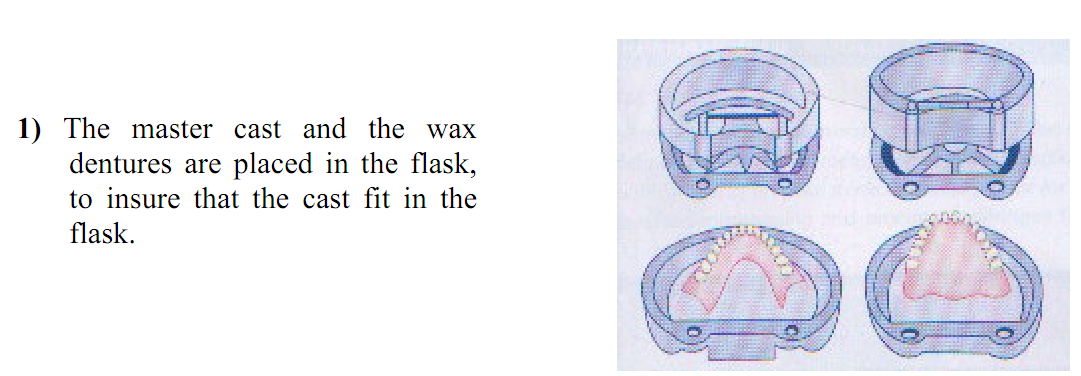

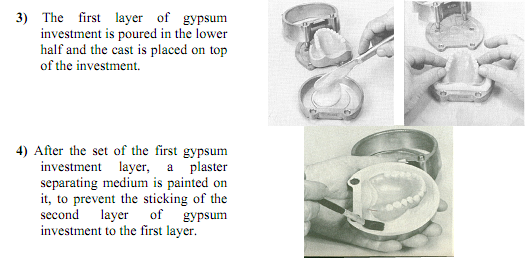
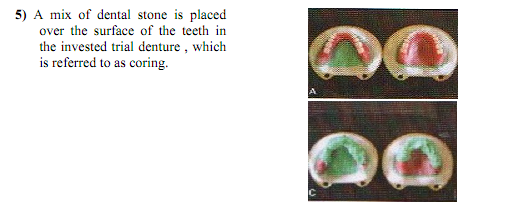


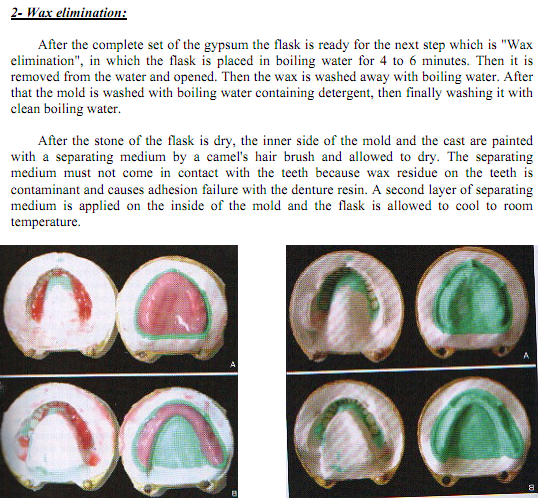
3- Mixing:
Acrylic resin dough is made by mixing the powder (polymer) and liquid (monomer) to form 'dough' which is packed into a gypsum mold for curing. The ratio of powder to liquid is important since it controls the workability of the mix as well as the dimensional changes on setting.
The mixing should be done in a clean jar which should be covered to prevent evaporation of the monomer.
4- Packing:
It should be done when the mixture reaches dough stage, as the dough is rolled into a rod-like form and placed in the upper half of the flask then a polyethelen (nylon sheet) is placed over the dough in the upper half and then the two halves of the flask are closed until they are almost in approximation, this is done to spread the dough evenly throughout the mold. Then the two halves of the flask are separated, the excess material at the borders of the denture is removed by a wax knife, and additional resin is added at any places that are deficient. At least two trial closures are done and before the final closure a thin layer separating medium is applied on the cast and the polyethelen sheet is removed and then the two halves of the flask are closed under pressure by bench press of about 100 Kg/cm2. Then the flask is put in a spring clamp and the clamp is closed tightly.
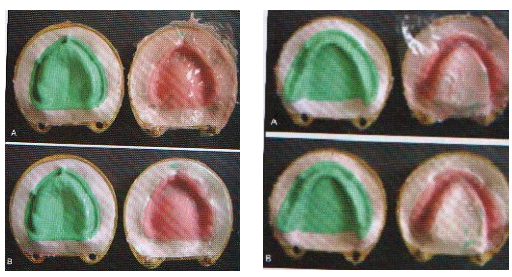
5- Curing:
It is polymerization of the hot cure acrylic to produce the final denture. The material is cured by heating in a water bath; pressure is applied during curing for the following reasons:
1- To decrease the effect of thermal expansion.
2- To decrease the polymerization shrinkage.
3- To increase the evaporation of monomer thus decreases porosity.
Types of curing cycles for heat cure acrylic:
1- Short curing cycle.
2- Long curing cycle.
1- Short curing cycle:
The denture is placed in water at room temperature and the curing temperature is programmed to 74 oC for one and half hour followed by 100oC for one hour.
2- Long curing cycle:
The curing temperature is programmed to 100 oC for 8 hours.
Polymerization can occur at any temperature but it is very slow at temperature below 70oC, the best curing cycle is the long curing cycle because most of the conversion of monomer to polymer occurs during the period at 70oC and during this time the dough itself may approach 100oC because the polymerization reaction exothermic. The monomer boils at 100.3oC so the dough must be kept below this temperature to avoid boiling of the monomer; on the other hand rapid curing cycle usually results in some gaseous porosity.
6- Deflasking:
Deflasking is the process of removal of the processed denture from the flask and investment mold. Before deflasking of the processed denture begins the flask is left to cool to room temperature. If not, increased distortion of the acrylic may occur.
Laboratory remount
The denture should be remounted on the articulator as dictated by the indices with sticky wax. The incisal pin discrepancy should be noted. If the discrepancy is less than 2mm, it is acceptable. If the discrepancy is between 2-5 mm, occlusal correction can be accomplished.
If the discrepancy is more than 5mm, the entire treatment should by repeated.

7- Shaping and Polishing:
In this step any excess acrylic is removed from the processed denture by the use of stone wheel burs, stone burs, and steel burs. Care must be taken not to heat the denture during grinding, because this may cause distortion of the denture base. Finally, the denture should be smooth and clean, as no plaster and no deep scratches should remain after the preparation for polishing.
In polishing a rag wheel with pumice is used for smoothing the denture. Then a final high polish is given to the denture with a rag wheel and polishing material (Rouge).
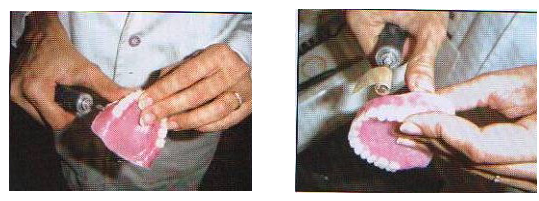

Special-purpose Training Tests for study the topic level testing
1. Patient with complete loss of teeth on the upper jaw is made a complete removable denture. After plastic polymerization the flask is removed from the hot and is rapidly cooled under running cold water. What do you think will happen in a plastic prosthesis basis in this case.
-pressure porosity is formed
-gas porosity is formed
-granular porosity is formed,
-the color of plastic changes
+microcracks occur
2. The patient, 57, is made a removable plate prosthesis for the upper jaw. On clinical and laboratory stages of its manufacture dental wax is used. Which group is the material related?
-insulation
-forming
-polishing
+ modeling
-impression
3. A patient, 73, addressed to the clinic with complaints of poor fixation of complete removable dentures, manufactured 10 years ago. On check-up: reducing the lower third of the face, a large uniform atrophy of the alveolar processes. Oclussion surface of artificial teeth is almost completely erased. After how many years of use removable dentures patient should change them.
-7-10 years
-7-8 years
-1-2 years
-9-10 years
+3-4 years
4.Patient,70, complaines of a lack of fixation of complete removable dentures on the upper jaw. Objectively: the edge of the prosthesis in the frenulum of the upper jaw is shortened, the locking valve is broken. What should be done to improve the fixation of the prosthesis.
+Denture reproduction
-Denture correction
-Expansion of denture basis edges
Extansion of denture basis edges
-Volumetric modeling of denture basis
5. The patient, 70, is made complete removable dentures for the upper and lower jaws. Formulation of artificial teeth produced by the method of Vasiliev. What kind of teeth in the upper denture inappropriately must not touch the glass.
-Canines and first molars,
-central incisors and first molars,
first and second premolars
+ lateral incisors and second molars,
-second premolars and first molars
6. Patient,47, is made complete removable dentures for the upper and lower jaws. The review stage of their construction shows protrusion of the upper lip. What stage was a mistake on?
-Determining the height of the lower third of the face
+ The formation of the vestibular surface of the bite roller,
-Forming the occlusal plane
-Determination of the height of the upper bite roller
-Central occlusion fixation
7. A patient,73, addressed to the prosthodontics clinic at the basis of fracture of complete removable dentures on the upper jaw. The prosthesis was made a year ago, of satisfactory quality. What plastics must be used to fix the prosthesis in this patient.
-Carboplast
+Protacril-М
-Bacrel
-Etacril
-Ftorax
8. The patient,70, with complete loss of teeth on the upper and lower jaws, is made complete removable dentures. Teeth setting will be conducted according to individual occlusal surfaces (the method of Napadov and Sapozhnikov). What material should rollers be made from for individual occlusal surfaces?.
-Adhesive wax
-Plastic
-Lavax
+waxabrasiv
-Stens
